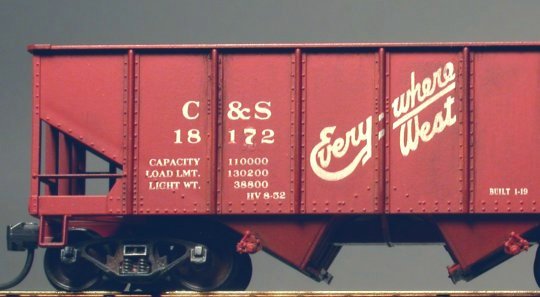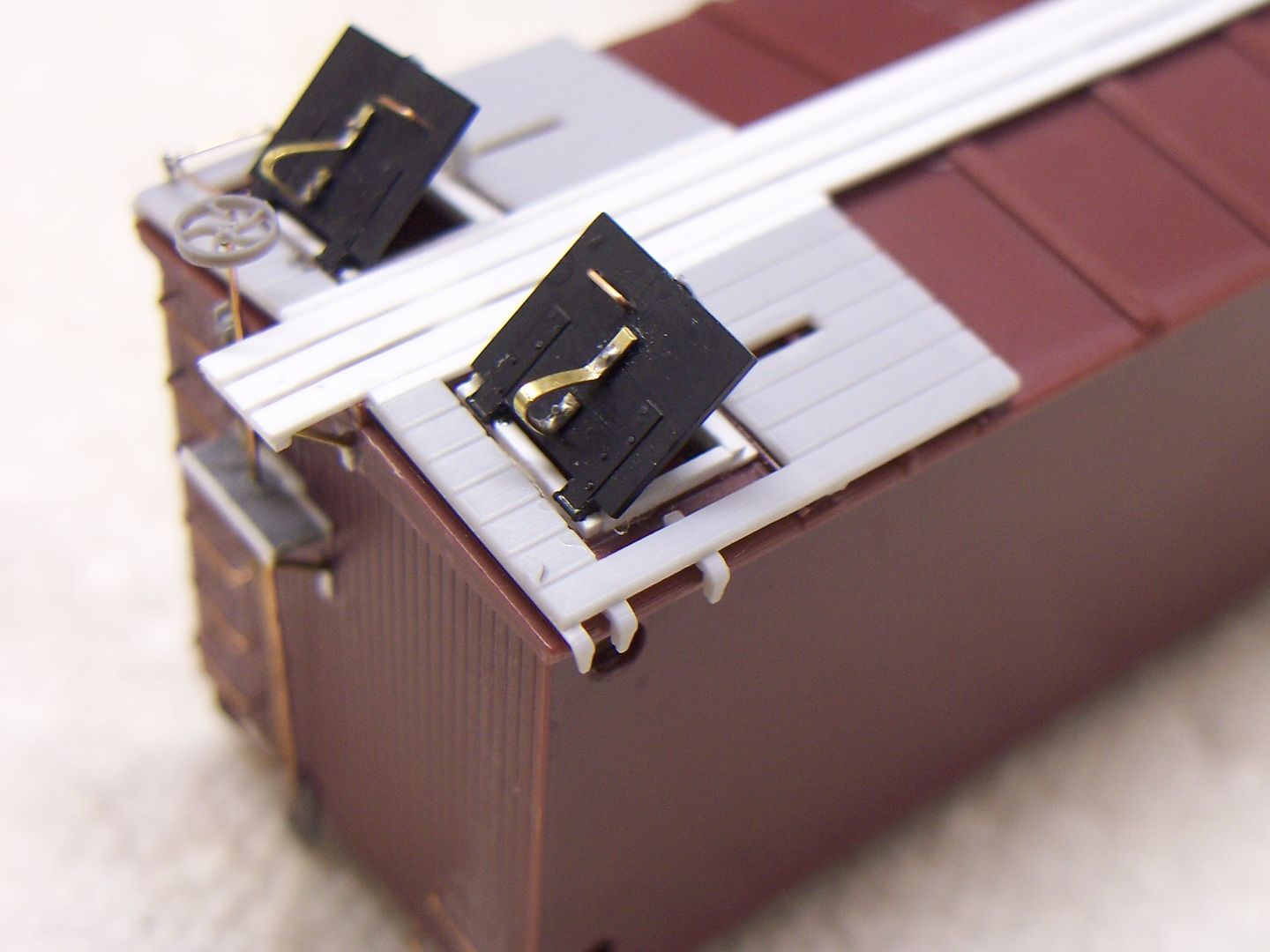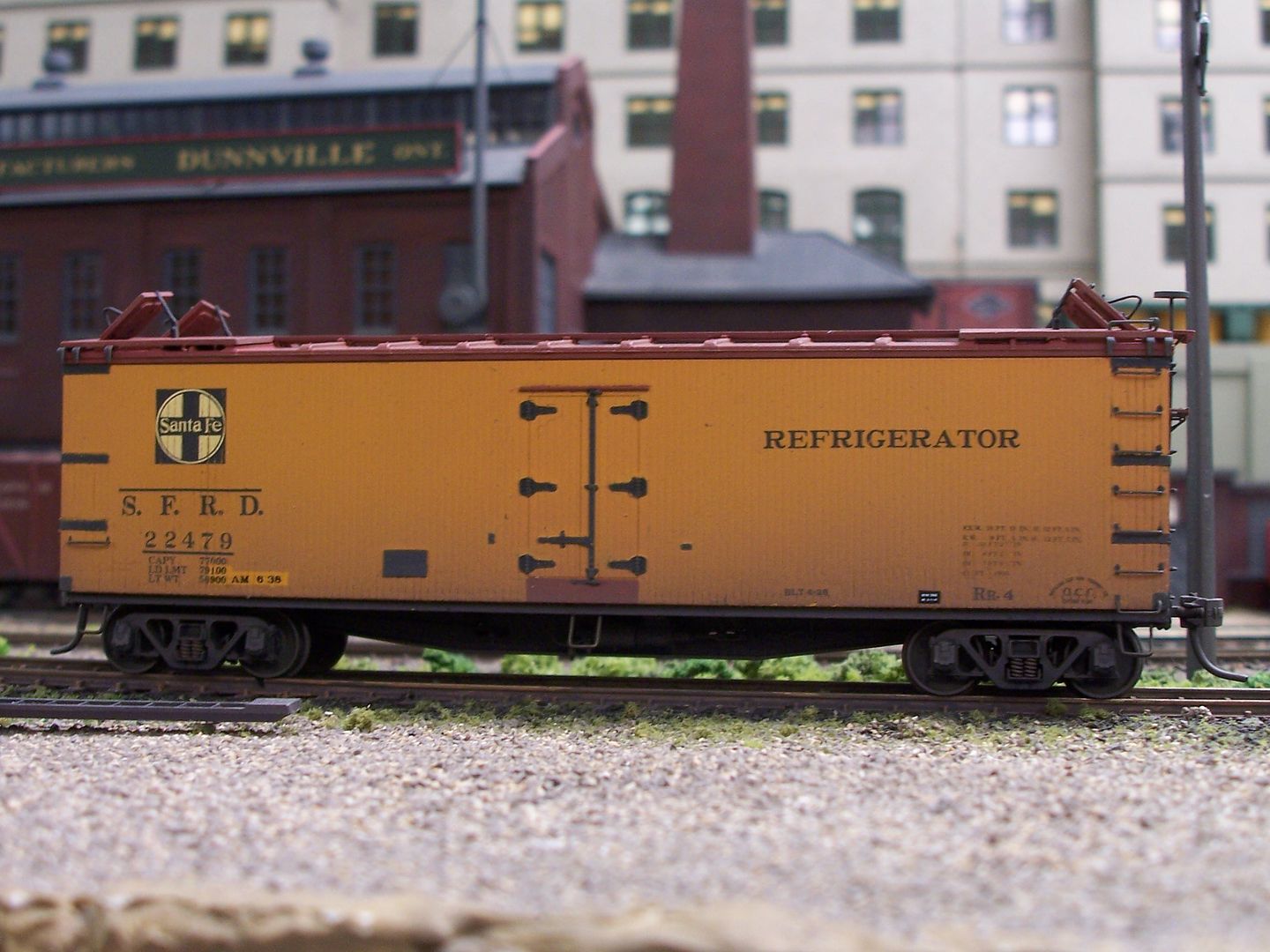Looking for some info on rolling stock, as to what era they belong. I’m currently roughly in the 1920’s era. So do box cars with the brake wheel on the end of the car fit, or do I stay with the brake wheel extended over the roof line? Wooden only, or steel? And what about tank cars, when did they evolve? I’m guessing anything over 40’ didn’t exist? Right now I’m running a Heisler as my main motive power. Thanks.
There is no one comprehensive document. There are lots of books on railroad equipment and histories of different types of cars.
In the 1920’s there would be early steel cars, wood sided cars and some composite cars. New boxcars would be steel and 40 ft. Older boxcars would be wood and 36-40 ft. Hopper cars would be mostly steel, 50-70 ton cars. Gons would mostly be in the 40-46 ft range steel or composite (steel underframes with wood sides.) Tank cars would be riveted and it 10k gal and under range. The cars could have vertical brake staff’s (horizontal wheel), geared handbrakes (vertical wheel) or a brake lever. All the cars would have air brakes and all the cars would have standard safety appliances (grab irons) and all th cars would have standard lettering. Covered hoppers would be extremely rare Flat cars would be in the 36-50 ft range.
Found this site HO scale models http://designbuildop.hansmanns.org/2013/01/16/1920s-era-freight-car-model-guide/
Westerfield provides era information on their kits and sell ORER (very useful info) on disk. Go to their store link from: http://www.westerfieldmodels.com/
Freight car markings inlcude a built/re-built date. A car built after the era you’re modeling obviously couldn’t have existed in your era. See marking on right side of image.

1921 Maintenance of Way Cyclopedia
Car Builders Cyclopedia 1909
Railway Locomotives and Cars 1908
https://books.google.com/books?id=GcZMxh9OIssC
The Story of the Pullman Car 1917
https://books.google.com/books?id=Mxg1AAAAMAAJ
Car Builders Cyclopedia 1895, 1903, 1906 - DVD for sale on EBAY
http://www.ebay.com/itm/Car-Builders-Cyclopedia-6-Railroading-Books-on-DVD-/181598345508
The first steel cars were built just before 1900. Most early all-steel freight cars were hoppers. In the mid-teens, some progressive and wealthy railroads like the PRR began to introduce steel boxcars such as the PRR X25. By the 1920’s, steel boxcars were becoming more popular; but many composite boxcars were being built for railroads all over the country. The ARA “standard” car (related to PRR’s X29) was introduced in the mid 1920’s and began to gain wide acceptance, although many composite cars remained in service until well after WWII.
Gondolas also changed from composite to all steel around the same time that boxcars did.
Tom
Hi,
I’m a stickler about not having any rolling stock/locos/autos on my layout past a 1960 build (or repaired) date. For the vast majority of cars, its simply a matter of looking up the dates (almost always the last two digits of the year) on the side of the car. There are often more than one - build date, plus repaint or repair dates.
Some generic or private use cars wayyy back when might not have a date so use your best judgement as to whether it fits or not.
Tank Cars
http://utlx.com/pdf/TankCarHistory.pdf
http://www.petroleumhistory.org/OilHistory/pages/TankCars/TankCars.html
Whwn 50’ Box cars?
By the mid-‘20s, 50’ boxcars were becoming much more common - most were single- or double-sheathed wood cars (steel framing with wood sheathing).
Some useful books (not restricted to the '20s though) would include Ted Culotta’s “Steam Era Freight Cars Reference Manual, Volume One”, which deals with box and automobile cars. Lots of photos and historical background info.
“Steam Era Freight Cars Reference Manual, Volume Two”, by the same author, covers all sorts of tank cars.
Also useful are Richard Hendrickson’s “Focus on Freight Cars, Volume One”, which covers single sheathed box and automobile cars, and “Focus on Freight Cars, Volume Two”, dealing with double sheathed box and automobile cars.
Some of the cars covered in these books are available as models, but many provide opportunities for scratchbuilders and kitbashers, too.
Accurail offers quite a few cars suitable for a '20s era layout, but since freight cars lasted for decades, not all of their paint schemes are necessarily appropriate for that period. Research on the prototypes can help you determine which are correct.
An Accurail USRA-type reefer, modified, then painted and lettered to represent the appearance common in the '20s. These cars were modernised starting in the '30s (my modelling era) but that programme continued into the '50s:
This photos shows some of the modifications:

…and the finished car:

…an Accurail USRA hopper. These were first built in 1918, but there were thousands of copies built in subsequent years. This car has a built date of 1919, and the only change I’ve made was to add a re-weigh
When I saw the subject heading, “Dating rolling stock”, the first thing that popped into my head was, “Somebody REALLY loves trains!” ![]()
But seriously, lots of great info posted here.
Ha ha, yes I agree, didn’t know quite how to word the header! Yes, lots of info, thank you everyone!
The most common house cars (boxcars, reefers, stock cars) would have been 40’ long with 8.5’ interior height - noticeably shorter than later 40’ boxcars from the 1930’s on, which would normally be 10.5’ high. An early all-steel boxcar was the X-29 originally used by the Pennsylvania.

http://www.walthers.com/exec/productinfo/910-1710
However most boxcars would have woodsides, some with wood ends and roofs, some with steel ends and roofs. Some would have single-sheathing with exposed bracing:

http://www.walthers.com/exec/productinfo/910-2503
Some would have double sheathing:
http://www.walthers.com/exec/productinfo/279-6320
These examples all have steel underframes, but cars with wood underframes and truss rods would be common into the 1930’s. Also 36’ cars or even a few 34’ cars would still be seen.
A tricky thing can be learning the lettering however. For example, the GN boxcar above may have built in the 1910’s or 1920’s, but that model is wearing the GN herald introduced in 1936, so would be wrong for a 1920’s layout.
It helps to memorize characteristics of rolling stock in different periods, but if you are lazy you can look at the dates printed on the sides of cars. Yes, not always accurate but usually a quick and dirty way to tell.
I’m glad those built dates are really small and hard to read because that way I can easily ignore them if I want to put a piece of rolling stock on my layout that post dates my time frame.
Yes, I too am a stickler for finding realistic build dates. Given that I model the early 1980s, I have cars from the 1950s to 1980s. This fits within the 40-year NMRA rule for cars and offers a lot of variety for types of cars. I love that some manufacturers put the build dates online which is different than many online sellers unless asked.
I even got an Athearn Genesis hopper in a set w/ a build date past my era. Call me crazy, but I traded it in at a show for two cars suitable for my era.
Careful though, that’s not the end of the story.
Look on the left side of the car, next to the weight information. That “HV 8-52” is a re-weigh date, with the “HV” representing a car shop doing the work. (CB&Q Havelock in this case). So this represents a car shopped or repainted in 1952, and the paint scheme, slogan and lettering likely bears no resemblance to its 1919 as-built appearance.
Chris brings up the other side of the coin - having cars built during or before your time period is one thing, making sure they’re lettered for your period is the other. Many of the models available for cars built in the 1920’s or earlier are often wearing later paint schemes. Except for reefers, generally freight cars of the 1920’s and earlier were very simple in their lettering. In the 1930’s, railroads started to use their freight cars to advertise their new streamlined passenger trains (“Way of the Zephyrs” on CB&Q cars, or Santa Fe ‘map’ cars touting the Chief, Super Chief, El Capitan etc.), or high-speed freight service (Cotton Belt “Blue Streak”).